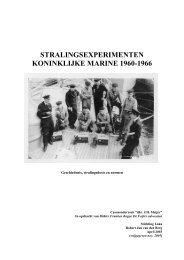CHERNOBYL; CHRONOLOGY OF A DISASTER - Antenna
CHERNOBYL; CHRONOLOGY OF A DISASTER - Antenna
CHERNOBYL; CHRONOLOGY OF A DISASTER - Antenna
Create successful ePaper yourself
Turn your PDF publications into a flip-book with our unique Google optimized e-Paper software.
At 1.23 hr on April 26, 1986, the fourth reactor of the Chernobyl<br />
nuclear power plant exploded.<br />
The disaster was a unique industrial accident due to the<br />
scale of its social, economic and environmental impacts and<br />
longevity. It is estimated that, in Ukraine, Belarus and Russia<br />
alone, around 9 million people were directly affected resulting<br />
from the fact that the long lived radioactivity released was<br />
more than 200 times that of the atomic bombs dropped on<br />
Hiroshima and Nagasaki.<br />
Across the former Soviet Union the contamination resulted in<br />
evacuation of some 400,000 people. About 200,000 km2 of<br />
land was, and is, contaminated by radioactive Caesium-137<br />
above 37,000 Bq/m2 (intervention level). In area terms, about<br />
3,900,000 km2 of Europe was contaminated by caesium-137<br />
(above 4,000 Bq/m2) which is 40% of the surface area of<br />
Europe. Curiously, this latter figure does not appear to have<br />
been published and, certainly has never reached the public's<br />
consciousness in Europe.<br />
This contamination will persist for centuries, and many<br />
countries as well as Belarus, Ukraine and Russia will need to<br />
continue with food restriction orders for decades to come.<br />
The economic consequences of the accident remain a massive<br />
burden on the countries most affected; Ukraine and<br />
Belarus continue to spend a large percentage of their Gross<br />
National Product on trying to deal with the consequences of<br />
the accident.<br />
About the health consequences of the Chernobyl accident,<br />
much research has been conducted, many reports have been<br />
written and still many uncertainties exist. Although official accounts<br />
points to 4,000 expected cancer deaths from Chernobyl<br />
in Belarus, Ukraine and Russia, the real prediction in IAEA/<br />
WHO reports is more than 9,000. Many other studies are<br />
expecting a multiple of that number. A 2009 publication that<br />
looked to Russian and Ukraine language reports, left out of<br />
the official studies, calculate a number of casualties of up to<br />
900,000. The full impact of the Chernobyl disaster may never<br />
be known.<br />
power plants are designed to withstand natural disasters (hurricanes,<br />
floods, earthquakes, etc.) and to withstand aircraft<br />
crash and blasts from outside. The safety is increased by<br />
the possibility in Russia to select a site far away from bigger<br />
towns." (page 647: "Zur Betriebssicherheit sind die Kraftwerke<br />
(VVER and RBMK) mit drei parallel arbeitenden Sicherheitsysteme<br />
ausgeruested. Die Kraftwerke sing gegen Naturkatastrophen<br />
(Orkane, Ueberschwemmungen, Erdbeben, etc)<br />
und gegen Flugzeugabsturz und Druckwellen von aussen<br />
ausgelegt. Die Sicherheit wird noch durch die in Russland<br />
moegliche Standortauswahl, KKW in gewisser Entfernung van<br />
groesseren Ortschaften zu erstellen, erhoeht."<br />
In the June 1983 issue of the IAEA-bulletin, Mr. B. Semenov,<br />
Deputy Director General, Head of IAEA Department of Nuclear<br />
Energy and Safety, sums up "many factors favoring the<br />
channel-type graphite-uranium boiling-water reactors" and<br />
concludes: "The design feature of having more than 1000<br />
individual primary circuits increasing the safety of the reactor<br />
system – a serious loss-of-coolant accident is practically<br />
impossible." (page 51)<br />
1972<br />
In 1972 a discussion took place in Kiev about the type of<br />
nuclear plant to be built at Chernobyl. Chernobyl's director,<br />
Bryukhanov, supported construction of Pressurized Water<br />
Reactors (PWRs). He informed the Ukraine Minister of Energy,<br />
Aleksei Makukhin, that an RBMK (a boiling water reactor)<br />
releases forty times more radiation than a PWR. However,<br />
the scientist Alekzandrov opposed this, saying that the<br />
RBMK-1000 was not only the safest reactor, it produced the<br />
cheapest electricity as well. For this reason it was decided to<br />
build the RBMK pressure tube reactors.<br />
1979<br />
February-March: according to data in the possession of the<br />
KGB, design deviations and violations of construction and<br />
assembly technology are occurring at various places in the<br />
construction of the 2nd generating unit, and these could lead<br />
The Chernobyl nuclear power plant:<br />
Type & Capacity Start Construction Criticality Shut down<br />
Block 1 RBMK-800 March 1970 September 1979 November 1996<br />
Block 2 RBMK-1000 February 1973 December 1978 October 1991<br />
Block 3 RBMK-1000 March 1976 December 1981 December 2000<br />
Block 4 RBMK-1000 April 1979 December 1983 April 1986<br />
Block 5 RBMK-1000 December 1981 - -<br />
Block 6 RBMK-1000 December 1983 - -<br />
RBMK's (also called Light-Water-Cooled, Graphite-Moderated Reactors, or LWGRs), use light water as a coolant and<br />
graphite as a moderator<br />
1- PRELUDE<br />
Chernobyl is safe…. Well, until April 26, 1986, that is…<br />
Before the Chernobyl accident very little was known about<br />
the Chernobyl type reactor, the RBMK. One of the few publications<br />
before 1986, in the December 1983 issue of the German<br />
nuclear industry monthly atomwirtschaft was written by<br />
H. Born from one of the main German utilities VEW. He writes:<br />
"For operational safety, the nuclear power plants (VVER and<br />
RBMK) are equipped with three parallel safety systems. The<br />
to mishaps and accidents. Similar report on Unit 1 (both units<br />
are in operation, at the time).<br />
1983<br />
December: The construction of Unit 4 at Chernobyl was<br />
completed by December 1983. On 21 December a press<br />
report was released which stated that the previous day the<br />
nuclear power plant had become operational. This news<br />
was reported by the media on 22 December, a festive day<br />
for workers in the energy industry. In the Soviet Union it was<br />
2<br />
Nuclear Monitor 724


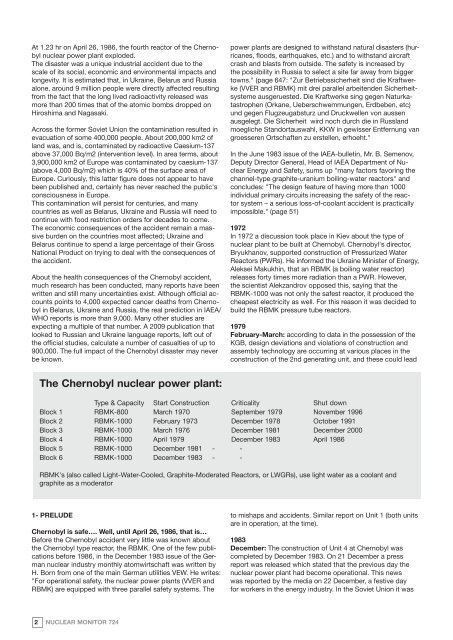
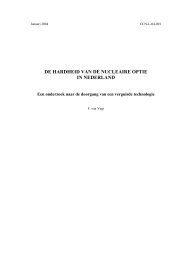


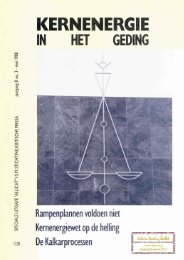
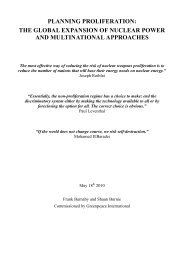





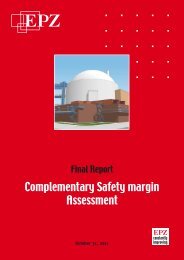

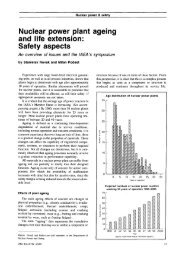
![EPZ jaarverslag 2009 [PDF] - Laka.org](https://img.yumpu.com/40394048/1/190x190/epz-jaarverslag-2009-pdf-lakaorg.jpg?quality=85)
